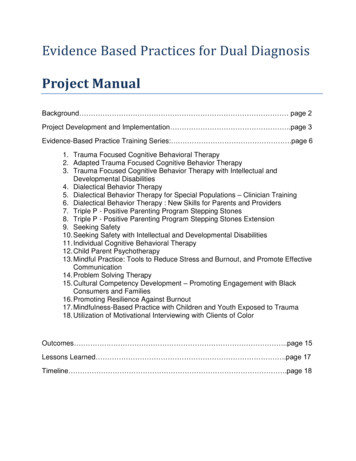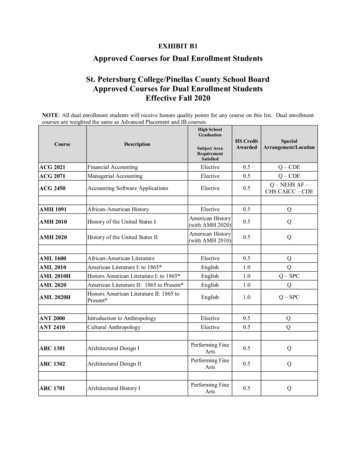
Transcription
Evidence Based Practices for Dual DiagnosisProject ManualBackground page 2Project Development and Implementation .page 3Evidence-Based Practice Training Series: .page 61. Trauma Focused Cognitive Behavioral Therapy2. Adapted Trauma Focused Cognitive Behavior Therapy3. Trauma Focused Cognitive Behavior Therapy with Intellectual andDevelopmental Disabilities4. Dialectical Behavior Therapy5. Dialectical Behavior Therapy for Special Populations – Clinician Training6. Dialectical Behavior Therapy : New Skills for Parents and Providers7. Triple P - Positive Parenting Program Stepping Stones8. Triple P - Positive Parenting Program Stepping Stones Extension9. Seeking Safety10. Seeking Safety with Intellectual and Developmental Disabilities11. Individual Cognitive Behavioral Therapy12. Child Parent Psychotherapy13. Mindful Practice: Tools to Reduce Stress and Burnout, and Promote EffectiveCommunication14. Problem Solving Therapy15. Cultural Competency Development – Promoting Engagement with BlackConsumers and Families16. Promoting Resilience Against Burnout17. Mindfulness-Based Practice with Children and Youth Exposed to Trauma18. Utilization of Motivational Interviewing with Clients of ColorOutcomes .page 15Lessons Learned .page 17Timeline .page 18
BACKGROUNDIndividuals with dual diagnoses of developmental disability and psychiatric disorder(s)(hereinafter, “dual diagnosis”) often have difficulty coping with distress, regulating theiremotions, and effectively self-soothing when upset. They also have a much higherlikelihood of being the victims of trauma than the general population and are less likely tobe resilient to the effects of trauma. Therefore, it is not surprising that individuals with dualdiagnosis exhibit a range of difficulties related to trauma exposure and have a relativelylow incidence of recovery from traumatic incidents without comprehensive anddevelopmentally appropriate therapeutic interventions. 1The majority of individuals with dual diagnosis receiving services from Westside RegionalCenter (“WRC”) seek mental health help through the Los Angeles County Department ofMental Health (“LAC DMH”).2 Yet, LAC DMH providers receive limited trainingopportunities on how to provide comprehensive and developmentally appropriatetherapeutic interventions to clients with dual diagnosis. 2 Thus, many clinicians struggle tofind effective and consistent therapeutic approaches to use with these clients. Additionally,LAC DMH providers are funded to provide Prevention and Early Intervention (PEI)therapies but are restricted to offering only specific and approved evidence-basedpractices (EBPs). These clinicians may benefit from interventions aimed at increasingclinical knowledge and improving understanding of how to adapt selected EBPs to providemental health services to individuals with dual diagnosis.To address the obstacles to developmentally appropriate mental health care for individualswith dual diagnosis through LAC DMH, WRC developed a plan to implement trainings forcommunity mental health providers on how EBPs approved by LAC DMH can be adaptedand used to more effectively to treat mental health issues in individuals with dualdiagnosis. Utilizing funding from the Mental Health and Services Act (MHSA) inpartnership with the Department of Developmental Services (DDS), WRC developed andimplemented the EBPs for Dual Diagnosis Project (the “Project”) during fiscal years 2014through 2017.This manual provides an overview of the Project, including a timeline of theimplementation steps (see Attachment 1), information about the EBP trainings, methodsfor outreach and recruitment, as well as a discussion of outcomes. We hope that theinformation contained in this manual will provide a useful model for anyone interested inpromoting and enhancing the wellbeing of individuals with dual diagnosis.1Burke T. Dual diagnosis: overview of therapeutic approaches for individuals with co-occurring intellectual/developmental disabilities and mental illness for direct support staff & professionals working in the developmentaldisability system. .pdf Accessed on December 21, 2016.2Unpublished needs assessment data.2
PROJECT DEVELOPMENT AND IMPLEMENTATIONThe development of the Project included the following steps:1.2.3.4.Establish Project’s leading teamDevelop partnership with LAC DMHConduct EBPs needs assessmentsImplement EBP trainingsEstablish Project’s Leading TeamWRC selected a Project team to plan, develop and execute the components of EBPProject. The project team was comprised of staff and vendors from WRC (e.g. departmentdirectors from Clinical Services, Community Services, and Client Services; psychologists;social workers; education and autism specialists; therapists and other allied healthprofessionals) as well as parent representatives from the Westside Family Resource andEmpowerment Center. All aspects of the Project were developed by the leading team withthe research and administrative support of the project coordinator.Develop Partnership with Los Angeles County Department of Mental Health (LACDMH)Project staff identified and met with the key LAC DMH administrators at their headquartersto discuss the Project’s goals and collaborate on the development and delivery of trainingsto LAC DMH clinicians for adapting EBPs to meet the needs of individuals with dualdiagnosis. The administrators included the District Chief of the Prevention and EarlyIntervention (PEI) Administration, the Mental Health Clinical Program Head of the PEIAdministration and the Mental Health Clinical Program Head of the Child, Youth andFamily Program Administration. Through this meeting, project staff were able to gathercrucial information regarding which EBPs are approved for use/billing by LAC DMHclinicians and for which client age groups. The administrators also shared with the leadingteam the LAC DMH training protocols for various EBPs and protocols for gathering needsassessment data from LAC DMH clinicians from the different Service Areas. Further, theadministrators provided feedback on how to effectively incorporate training materialsspecifically addressing treatment of clients with dual diagnosis into the EBP trainings.Conduct EBPs Needs AssessmentProject staff conducted a two-part needs assessment to determine, first, which EBPs weremost suitable to be adapted for individuals with dual diagnosis and, second, in which ofthose EBPs did LAC DMH clinicians most need training. For the first part of the needsassessment, Project staff utilized previously collected survey data of local mental health3
and behavioral health providers. This data was collected during Cycle II of MHSA grantfunding (please contact Project staff for a copy of the questionnaire).Next, Project staff developed a new survey for LAC DMH clinicians to determine the levelof demand for training in each of the EBPs identified in the first part of the needsassessment, identify any additional EBPs that could be helpful for working with clients withdual diagnosis and to address the scheduling and location of the trainings (see Attachment3 for Mental Health Provider Questionnaire). Following the protocol established during themeeting with LAC DMH administration, Project staff contacted the individual LAC DMHDistrict Chiefs and Regional Center Liaisons from the three LAC DMH Service Areas (SA5, 8, and 6) that overlap with WRC’s geographic catchment area. Project staff explainedthe goals of the Project and enlisted support from the Chiefs and Liaisons in bothgathering needs assessment data from agencies/clinicians and recruiting clinicians toparticipate in the upcoming EBP trainings in their corresponding Service Areas. The LACDMH Regional Center Liaisons assisted in the needs assessment process by invitingProject staff to present the Project and distribute surveys at various LAC DMH staffmeetings as well as emailing surveys to agencies/clinicians in their Service Areas throughtheir list serves. The LAC DMH Regional Center Liaisons also provided Project staff withdata on which EBPs were utilized by each agency within each Service Area.The results from needs assessments indicated the following EBPs as being most neededand effective in treating clients with dual diagnosis: Trauma-Focused Cognitive Behavior Therapy (TF-CBT)Dialectical Behavior Therapy (DBT)Positive Parenting Program (Triple P)Seeking Safety (SS)Individual Cognitive Behavior Therapy (Ind CBT)Child-Parent Psychotherapy (CPP)Managing and Adapting Practice (MAP)In addition, Project staff learned through the needs assessment process that many LACDMH clinicians had little or no familiarity with the regional center system but wereinterested in learning more about how the system works. It was, therefore, important toincorporate detailed information about the regional center system into the EBP trainingevents.Implement EBPs TrainingsProject staff collected and analyzed information about training costs (including costs forproviding continuing education credits to licensed clinicians) and the duration of completetrainings for the various EBPs identified in the needs assessment. They also developed atraining timeline for all three fiscal years of the Project based on budgeted costs.4
As requested by the LAC DMH administers working in partnership on the Project, Projectstaff adhered to all training protocols developed by the LAC DMH Prevention and EarlyIntervention (PEI) Division. The training protocols included information on all approvedEBPs, training coordinators and authorized trainers, training materials, minimum trainingrequirements before agencies are allowed to bill for their services under PEI, certification,and specific EBP training protocols and costs. A copy of the training protocols is availableat http://file.lacounty.gov/SDSInter/dmh/201947 PEITrainingProtocolsrevised4-1-16.pdf.Next, Project staff contacted and collaborated with implementation consultants from eachEBP organization identified in the training protocols (i.e., TF-CBT, Triple P, SS, DBT,MAP, CPP, etc.) to find the most appropriate trainers for the needs of this Project and todetermine logistics and costs for implementing trainings for different clinical cohorts. Theproject coordinator also identified and contacted potential trainers for each EBP training todiscuss logistics, including fees, training curriculum, case studies pertaining to dualdiagnosis, role playing, and training evaluations (pre, post, and three to six month followup). Case studies and role-playing exercises specific to clients with dual diagnosis wereadded to the curricula where appropriate. (No part of the original EBP training materialwas substituted or eliminated to accommodate such case studies and role-playingexercises). Project staff also created training flyers, online registration pages throughEventbrite.com, and evaluations. LAC DMH Liaisons for each Service Area in WRC’scatchment area assisted Project staff in recruitment by sharing flyers and registrationinformation via their email list serves. In addition, Project staff was able to coordinate theprovision of Continuing Education Units (“CEUs”) to licensed clinicians participating in thetrainings. EBP trainings including free CEUs are difficult to find in the community, soProject staff was able to use the CEUs as incentives to increase enrollment in thetrainings.5
EVIDENCE-BASED PRACTICE TRAINING SERIES31. Trauma Focused Cognitive Behavioral Therapy (TF-CBT)Trauma Focused Cognitive Behavioral Therapy (TF-CBT) is an evidence-basedpsychotherapeutic intervention designed to help children, youth, and their parentsovercome the negative effects of traumatic events. It was developed by integratingcognitive and behavioral interventions with traditional child abuse therapies focusing onenhancing interpersonal trust and client empowerment. LAC DMH authorizes this EBP fortreating children ages 3-18. Through this Project, a certified TF-CBT trainer administeredthe following protocols to training participants: 2-Day Initial TF-CBT Training (2-days for clinicians and an extra ½ day for TF-CBTsupervisors).16 consultation calls (up to eight clinicians per call including a TF-CBT supervisor).Booster Training (1 day for clinicians and an extra ½ day for TF-CBT supervisors)six months after the initial training.Participants complete and submit up to two audio taped sessions for review bytrainer.Training participants who completed all of the above-listed protocols obtained nationalcertification in the TF-CBT EBP through the Project. The 2-day initial training portion of theprotocol was made available to a wider group of participants, some of whom only intendedto complete the 2-day initial training and did not go on to become certified in TF-CBTthrough this Project.Training Objectives Included: Identify important assessment and engagement strategies for working with familiesutilizing the TF-CBT modality.Understand what constitutes complex trauma and how it differs from isolatedtraumatic events, with implications for assessment and treatment.Review the ‘PRACTICE’ components of TF-CBT and ensure the application ofcomponents in a structured, gradual exposure manner.Identify and share creative applications of the ‘PRACTICE’ components.Focus on the Trauma Narrative and Cognitive Component, through case examplesand role-plays.2. Adapted Trauma Focused Cognitive Behavioral Therapy (TF-CBT)Individuals with dual diagnosis experience high rates of abuse and neglect. In this oneday training (geared toward participants with previous background and knowledge of TFCBT), the trainer examined factors contributing to this population’s vulnerability, clinical3Please visit http://reachacrossla.org/programs/ebps/ to see copies of the training flyers, curricula, handouts and othermaterials for this training. You may also contact Aga Spatzier, MPH, Wellness Manager, at agas@westsiderc.org torequest additional Project materials such as training surveys, pre and posttests, etc.6
symptoms of traumatic stress, assessment techniques and cultural competencies. Thetrainer presented an in-depth, phase oriented trauma treatment model based on TF-CBTwith adaptions for individuals with dual diagnosis. The training also included considerationof caregivers and other systems of care as well as therapists’ vicarious traumas.Training Objectives Included: Examine high rates of abuse and neglect among people with disabilities and factorscontributing to this vulnerability.Discuss trauma assessment techniques to help clinicians with diagnosticovershadowing and differential diagnosis.Practice components of phase oriented trauma treatment and the adaptations to themodel for individuals with intellectual and developmental disabilities.Explore techniques to incorporate therapist and caregiver resilience into traumatreatment in the presence of vicarious trauma.3. Trauma Focused Cognitive Behavioral Therapy (TF-CBT) with Intellectual andDevelopmental Disabilities WorkshopThis 3-hour workshop was available to community mental health providers to strengthentheir knowledge of regional center eligibility and services, familiarize them with profiles ofclients with dual diagnosis and demonstrate the application of TF-CBT with to clients withdual diagnosis. The workshop also provided participants with an increased understandingof the clinical challenges and adaptive application of EBPs in the mental health treatmentof individuals with dual diagnosis. Participants had the opportunity to review vignettematerials and discuss case challenges using TF-CBT.Training Objectives Included: Demonstrate knowledge of the regional center system (i.e., eligibility and services).Demonstrate understanding of developmental differences, including intellectualdisabilities.Apply the TF-CBT model with populations presenting with intellectual anddevelopmental disabilities.Demonstrate understanding of how developmental differences and cognitive deficitsimpact the adaption of evidence-based practices.4. Dialectical Behavior Therapy (DBT)Dialectical Behavior Therapy (DBT) is a cognitive behavioral treatment developed to treatchronically suicidal individuals diagnosed with borderline personality disorder, and it is nowrecognized as the gold standard psychological treatment for this population. In addition,research has shown that DBT is effective in treating a wide range of other disorders suchas substance dependence, depression, post-traumatic stress disorder, and eatingdisorders. This EBP is authorized for individuals 18 and older. Through this Project, acertified DBT trainer administered the following protocols to training participants:7
2-Day Introductory DBT Training.1-Day “Nuts and Bolts” Training.Weekly DBT Consultation Team meeting (1.5 hours per week)1 year of monthly in-person consultation with DBT trainer at weekly DBT teamConsultation Team Meeting.Training Objectives Included: Explain the model of emotion dysregulation and the bio-social theory.Conceptualize suicidal ideation, self-harm, and other problem behaviors from thebio-social model using behavioral therapy.Utilize principles of DBT in therapy sessions including a dialectical stance and anonjudgmental, validating approach toward the client.5. Dialectical Behavior Therapy for Special Populations (DBT-SP) – ClinicianTrainingDialectical Behavior Therapy for Special Populations (DBT-SP) is an adapted treatmentapproach designed to assist clinicians and care providers working with dual diagnosis. Thetreatment approach addresses inability to tolerate distress, emotional instability anddysregulation, and interpersonal difficulties. This day and a half training was developed forclinicians interested in learning how to adapt their clinical DBT skills to working with clientswith dual diagnosis and their family members.Training Objectives Included: Become familiar with core terms and principles of DBT-SP.Learn characteristics of dysregulation and ways of supporting clients in usingdistress tolerance, emotion regulation, and relationship skills.Become familiar with group dynamics and increase group skills.Become skillful at leading therapeutic groups for individuals with developmentaldisabilities and behavioral/mental health needs.6. Dialectical Behavior Therapy: New Skills for Parents and Providers to DecreaseStress and Improve Cooperation and Relationships with Children and Adults withDevelopmental Disabilities and Mental Health Needs – Workshop for Parents andProvidersThis four-hour workshop was designed to help parents improve relationships with theiryoung and adult children through the use of DBT strategies. The workshop also offered anintroduction to DBT and interventions that providers could use when working withindividuals with dual diagnosis.Training Objectives Included: Learn ways to decrease conflict.Increase cooperation and tolerance for distress.Improve communication and relationship skills.8
7. Triple P – Positive Parenting Program (Standard Stepping Stones – Level 4)Standard Stepping Stones Triple P is designed to treat behavioral and emotional problemsspecifically in children (up to age 12) with a developmental disability. It provides parentswith comprehensive support in managing their child’s behavior across settings (i.e.disobedience, fighting and aggression, and temper tantrums). The training offered throughthis Project aimed to help clinicians provide parents with a variety of parenting skills thatwill promote their child’s development and potential. A certified Triple P traineradministered the following protocols for training participants: 3-day Initial Training.1-day pre-accreditation workshop.1-day accreditation workshop.Training Objectives Included: Detect and effectively manage child behavior problems.Recognize risk and protective factors operating within families.Describe core principles of positive parenting and behavior change.Perform advanced assessment of child and family functioning.Apply key parenting strategies to a broad range of target behaviors.Identify strategies for promoting generalization and maintenance of behaviorchange.Recognize indicators that suggest the presence of additional family risk factors.8. Triple P – Positive Parenting Program (Standard Stepping Stones – Level 4EXTENSION Course)All clinicians who attended this 1-day Extension course were already accredited in Level 4Standard Triple P (which is not designed specifically for children with developmentaldisabilities) and took this shorter course to increase their clinical Triple P knowledge andlearn how to assist parents of children with developmental disabilities and challengingbehaviors.Training Objectives Included: Early detection and effective management of child behavior problems.Risk and protective factors operating within families.Core principles of positive parenting and behavior change.Advanced assessment of child and family functioning.Application of key parenting strategies to a broad range of target behaviors.Strategies for promoting generalization and maintenance of behavior change.Identification of indicators suggesting the presence of additional family risk factors.9. Seeking Safety (SS)9
Seeking Safety (SS) is a present-focused counseling model to help people attain safetyfrom trauma and/or substance abuse. The model was designed for flexible use. It can beconducted in a group or individual format; for men and women; adults or adolescents; forany length of treatment; any level of care (i.e. outpatient, inpatient, residential); for anytype of trauma and any type of substance. This EBP is authorized for ages 13 and up. Acertified SS trainer administered the following protocols: 1-day or 2-day Training (WRC organized both one and two day trainings for threedifferent cohorts of clinicians) with access to the SS manual during and aftertraining.Developer highly recommends participation in Theme Based Calls (TBCs).Training Objectives Included: Understand evidence-based treatment of trauma and substance abuse.Increase empathy and understanding of trauma and substance use.Describe SS, an evidence-based model for trauma and/or substance abuse.Provide assessment and treatment resources.Identify how to apply SS for specific populations, such as homeless, adolescents,criminal justice, HIV, military/veteran, individuals with developmental disabilities,etc.10. Seeking Safety (SS) with Intellectual and Developmental Disabilities WorkshopThis 3-hour workshop was available to community mental health providers to strengthentheir knowledge of regional center eligibility and services, familiarize them with profiles ofclients with dual diagnosis and demonstrate the application of SS with clients with dualdiagnosis. The workshop also provided participants with an increased understanding ofthe clinical challenges and adaptive application of EBPs in the mental health treatment ofindividuals with dual diagnosis. Participants had the opportunity to review vignettematerials and discuss case challenges using SS.Training Objectives Included: Demonstrate knowledge of the regional center system (i.e., eligibility and services).Demonstrate understanding of developmental differences, including intellectualdisabilities.Apply the SS model with populations presenting with intellectual and developmentaldisabilities.Demonstrate understanding of how developmental differences and cognitive deficitsimpact the adaption of evidence-based practices.11. Individual Cognitive Behavioral Therapy (Ind CBT)Cognitive Therapy was developed by Dr. Aaron T. Beck to treat depression, and it hasbeen shown to be an effective treatment for a range of mental health problems. Ind CBT isa practical, empirically based, present-focused approach to treatment that focuses on10
interconnections between our thoughts, behaviors, and moods. Ind CBT helps peopleidentify their distressing thoughts and evaluate how realistic those thoughts are. Theemphasis in Ind CBT is on solving problems and initiating behavior change. This EBP isauthorized for individuals 18 and older. A certified CBT trainer administered the followingprotocols: 3-day Initial Training (18 hours).16 weekly 55 minutes Consultation Calls (no more than 8 clinicians per call).Submission of 1 audiotape and 1 case conceptualization on 3 current CBT clientsreviewed by CBT trainer or designated consultant.1-Day Booster Training (6 hours).Training Objectives Included: The three primary components of the CBT model for the treatment of anxiety anddepressive disorders.Two adjustments to CBT for the treatment of anxiety and depression in adults withdevelopmental disabilities.The primary steps to build a case conceptualization and treatment plan for anxietyand depressive disorders in adults with developmental disabilities.The primary features of structuring a CBT session with adults with developmentaldisabilities.Two typical cognitive interventions in the treatment of anxiety and depressivedisorders in adults with developmental disabilities.Two typical behavioral interventions in the treatment of anxiety and depressivedisorders in adults with developmental disabilities.12. Integrating Mental Health EBPs with Co-Occurring Intellectual Disabilities: ChildParent Psychotherapy (CPP)This 3-hour workshop was available to community mental health providers to strengthentheir knowledge of regional center eligibility and services, familiarize them with profiles ofclients with dual diagnosis and demonstrate the application of CPP with to clients with dualdiagnosis. Training participants explored the core concepts of evidence-based practices inspecial needs infant-preschooler populations, evaluated mental health treatment issuesspecific to special needs populations and trauma, and discussed integration of the CPPmodel. Participants also had the opportunity to share and explore treatment concerns andchallenges.Training Objectives Included: Demonstrate knowledge of the Regional Center system (i.e., eligibility andservices).Demonstrate knowledge of trauma and special needs population.Demonstrate understanding of developmental differences impact on traumatreatment.Apply the CPP model with case study of intellectual and developmental disabilities.11
Demonstrate understanding of how developmental differences and cognitive deficitsimpact the adaption of evidence-based practice, CPP.13. Mindful Practice: Tools to Reduce Stress and Burnout, and Promote EffectiveCommunicationTwo separate four-hour trainings were offered to WRC service coordinators and othersupport staff directly working with individuals with or at risk for dual diagnosis and theirfamily members. Since we cannot always control what is outside of ourselves, we can usetools, like Mindfulness, to help reduce stress, create calm, promote effectivecommunication, and cultivate a greater sense of fulfillment. This training allowedparticipants to explore the foundations of mindfulness through awareness of the body,emotions, and thoughts through both formal and informal on-the-spot practices.Training Objectives Included: Learn the benefits of mindfulness.Learn how to increase awareness.Demonstrate understanding of emotion regulation.Apply mindful communication in daily interactions with others.14. Problem Solving Therapy (PST)Problem Solving Therapy (PST) is an evidence-based treatment intended to break thecycle between overwhelming life stressors and symptoms of depression, anxiety, ordistress. PST has been found to be effective for a wide range of difficulties, includingmajor depressive disorder, generalized anxiety disorder, emotional distress, suicidalideation, relationship difficulties, certain personality disorders, poor quality of life andemotional distress related to medical illnesses. This training provided participants with asolid foundation in the rationale, research support, and clinical application of PST througha combination of didactic instruction, audiovisual demonstration, and role play practice.Training Objectives Included: List and describe each of the seven steps of PST.Assess an individual client’s suitability for PST.Explain the rationale and structure of PST to clients.Utilize the PST steps and action-planning worksheet to break down a life problemand develop an action plan to address it.15. Cultural Competency Development – Promoting Engagement with BlackConsumers and FamiliesThis 3-hour workshop was available to community mental health providers to facilitatecultural competency in clinicians and therapists who provide psychosocial support toclients identifying as Black-/African- Americans. Content provided information on thecommon experiences of African Americans within the U.S. context. Content also12
addressed the research on racial disparities and its application to the field of mental andbehavioral health. The course particularly addressed the experiences of dually diagnosedAfrican Americans and examined the factors involved in effective treatment engagement.The workshop also highlighted the key skills necessary to developing cross-culturalproficiency.Training Objectives Included: List the factors that lend to racial disparity in mental health service utilization forAfrican Americans.Describe the factors that are associated with mental health in African Americans.Convey an understanding of the intersectionality of developmental disability, mentalhealth conditions and culture and how this influences one’s experience andtreatment.Identify the clinical skills associated with the development of cultural proficiency inwork with African Americans and African American families.16. Promoting Resilience against Burnout WorkshopTwo separate 3-hour trainings were offered to WRC
7. Triple P - Positive Parenting Program Stepping Stones 8. Triple P - Positive Parenting Program Stepping Stones Extension 9. Seeking Safety 10. Seeking Safety with Intellectual and Developmental Disabilities 11. Individual Cognitive Behavioral Therapy 12. Child Parent Psychotherapy 13.











